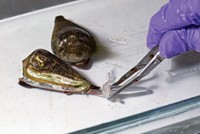Advertisement
Grab your lab coat. Let's get started
Welcome!
Welcome!
Create an account below to get 6 C&EN articles per month, receive newsletters and more - all free.
It seems this is your first time logging in online. Please enter the following information to continue.
As an ACS member you automatically get access to this site. All we need is few more details to create your reading experience.
Not you? Sign in with a different account.
Not you? Sign in with a different account.
ERROR 1
ERROR 1
ERROR 2
ERROR 2
ERROR 2
ERROR 2
ERROR 2
Password and Confirm password must match.
If you have an ACS member number, please enter it here so we can link this account to your membership. (optional)
ERROR 2
ACS values your privacy. By submitting your information, you are gaining access to C&EN and subscribing to our weekly newsletter. We use the information you provide to make your reading experience better, and we will never sell your data to third party members.
Biological Chemistry
Bedbugs Beat Pesticides Their Own Way
Bloodsucking insects beef up defenses near their exoskeletons—a trick no other insect uses
by Carmen Drahl
March 18, 2013
| A version of this story appeared in
Volume 91, Issue 11
Bedbugs have evolved an insecticide-resistance strategy unlike that of any other pest: They beef up levels of pesticide-detoxifying genes in a layer of cells just beneath their exoskeletons, according to a study (Sci. Rep., DOI: 10.1038/srep01456). That information might help chemists design more effective ways to control bedbug infestations. Subba R. Palli and colleagues collected bedbugs from dwellings in Cincinnati, Louisville, and Lexington, the home of their institution, the University of Kentucky. The researchers analyzed the pests’ RNA transcriptomes, along with those of bedbugs raised in the lab. They learned that bedbugs stave off pesticides such as deltamethrin in multiple ways, in particular by increasing levels of pesticide-detoxifying cytochrome P450 enzymes and transporter proteins that pump the chemicals out of cells. Many insects use those strategies, but they don’t concentrate their efforts near their exoskeleton the way bedbugs do. Because bedbugs feed on blood and not poisoned bait, insecticides targeting them are designed to kill on contact. It seems the pests may have adapted by strengthening the key cellular barrier under the exoskeleton as a first line of defense, the researchers say.




Join the conversation
Contact the reporter
Submit a Letter to the Editor for publication
Engage with us on Twitter